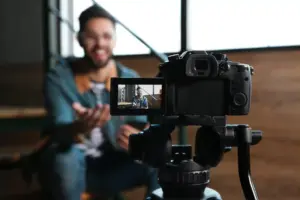Why AR marketing and VR marketing deserve your attention
Consumer expectations have shifted toward interactive, 3D product experiences. Shoppers want to see items at scale, in context, and on their terms—before they buy. AR marketing enables real‑time visualization on mobile devices, while VR marketing creates fully immersive brand worlds for discovery, demos, and events.
Real‑world signals are compelling. Snapchat reports hundreds of millions of people interact with AR experiences monthly, and major retailers have documented conversion lifts when adding 3D/AR to product pages. In independent research on VR’s effectiveness for learning and persuasion, PwC found VR participants were 4x faster to train and 3.75x more emotionally connected—benefits that translate into deeper product understanding during VR marketing demos and virtual events.
In short: immersive media is no longer a novelty. It’s a performance channel with clear use cases across the funnel.
Set the right goals: From awareness to conversion
Before production, map your objectives to formats and KPIs. Not every AR filter or VR experience is built for direct sales, and that’s okay—just measure accordingly.
- Awareness: Branded lenses, location‑based AR stunts, VR premieres. KPIs: reach, unique users, share rate, brand recall lift.
- Consideration: WebAR try‑on/try‑in, 3D product configurators, VR showrooms. KPIs: dwell time, interaction rate, product views, and add‑to‑cart.
- Conversion: AR product visualization on PDPs, shoppable AR ads, VR guided demos with CTAs. KPIs: conversion rate, AOV, revenue per session.
- Loyalty: Post‑purchase AR manuals, VR community events, tokenized collectibles. KPIs: repeat visits, NPS, and user‑generated content volume.
Align your creative brief, data capture plan, and tech stack with these outcomes to avoid “cool but unmeasured” activations.
AR marketing fundamentals: What works right now
AR thrives on utility and shareability. The most successful AR marketing work either solves a shopper problem (fit, size, color, context) or unlocks playful self‑expression that people want to share.
1) Make utility the hero with WebAR and 3D on PDPs
For retail and DTC, WebAR—accessed via a browser link or QR code—reduces friction and avoids app downloads. Embed 3D/AR viewers on product detail pages so customers can place items true‑to‑scale at home or try cosmetics and eyewear on their face.
- Use cases: Furniture scaling, paint visualization, cosmetics try‑on, footwear sizing, and home improvement tools.
- Tips: Optimize 3D models (under 5–8 MB), include accurate PBR materials, and provide environment occlusion for realism.
- Proof: Retailers consistently report higher engagement and add‑to‑cart rates with 3D/AR visualization compared to static images.
2) Activate social AR for reach and UGC
Platforms like Snapchat, Instagram, and TikTok offer AR lenses with massive distribution. Pair a branded effect with a clear challenge or incentive to fuel user‑generated content.
- Concept: Transformations, gamified challenges, collectible try‑ons.
- Creative: Keep interactions under 10 seconds to a “wow” moment, and add subtle guides (“Open your mouth to…”).
- Media: Support your lens with paid reach to hit critical mass; optimize for share rate and completion.
3) Bridge online‑offline with location‑based AR
Geo‑anchored AR murals, scavenger hunts, and store‑specific effects drive footfall and PR. Use QR codes on OOH placements to launch WebAR moments in seconds.
- Measurement: Foot traffic lift, coupon redemptions, local sales.
- Partnerships: Collaborate with artists or creators to increase authenticity.
4) Build a scalable 3D asset pipeline
AR depends on quality 3D assets. Create a repeatable workflow: CAD intake or 3D scanning, optimization, QA, and SKU‑to‑viewer publishing. Maintain a central asset library to reuse models across PDPs, ads, and configurators.
VR marketing playbook: Immersion that persuades
Use VR marketing when the product benefits from immersion: complex B2B machinery, travel destinations, real estate, automotive, or premium brand worlds that warrant exploration.
1) Virtual showrooms and guided demos
Create shoppable VR environments or guided walkthroughs for sales teams and events. Include embedded hotspots that reveal specs, play testimonials, or trigger 3D animations that explain features in context.
- Distribution: Headset apps for trade shows, or WebVR for browser‑based access.
- CTA design: Always provide an exit path to a lead form, calendar booking, or checkout.
2) Event marketing and product launches
VR premieres can democratize access to launches and drive press. Pair a virtual keynote with interactive stations and exclusive digital collectibles for attendees.
3) Training as marketing
Prospective customers who “learn by doing” retain value propositions better. In PwC’s study of VR learning, participants were faster to train and more emotionally connected—advantages that carry into VR marketing demos, where a detailed understanding combats objections and accelerates decisions.
PwC’s VR effectiveness study outlines these gains in detail.
Creative principles for high‑performing AR marketing and VR marketing
- Lead with a single promise: “See this sofa in your living room” beats a generic “Explore our brand.”
- Design for speed: Aim for sub‑3‑second load; lazy‑load textures; offer a 3D preview while AR initializes.
- Make it touch‑friendly: Large controls, haptic feedback, and clear on‑screen cues reduce drop‑off.
- Tell a story: Use progressive reveal—intro, interact, reward—to sustain attention.
- Accessibility matters: Provide captions, audio cues, and alternatives for motion‑sensitive users.
- Brand lightly: Keep logos subtle; let the utility or magic carry the experience.
Technology choices: Platforms, tools, and build vs. buy
Your stack should reflect goals, budget, and timelines. Below are common routes used by teams succeeding with AR marketing and VR marketing.
AR technology
- WebAR: 8th Wall, Zappar, Niantic Lightship WebAR for browser‑based activations.
- Social AR: Snap Lens Studio, Meta Spark, TikTok Effect House for reach and UGC.
- On‑site AR: Apple ARKit and Google ARCore for custom iOS/Android apps.
- 3D asset tools: Blender, Substance, Reality Converter, USDZ/GLB pipelines.
VR technology
- Game engines: Unity or Unreal for custom, high‑fidelity worlds.
- No‑code platforms: Web‑based VR creation tools for rapid prototyping and browser access.
- Distribution: Meta Quest Store for headset apps; WebXR for instant access across devices.
Build vs. buy
- Build: Full control, reusable components, higher upfront cost, and timeline.
- Buy/partner: Faster time‑to‑market, proven templates, platform support—tradeoffs on flexibility.
Measurement that matters: KPIs and testing frameworks
Immersive experiences generate rich interaction data. Treat them like performance assets, not stunts.
Core AR marketing metrics
- Load and start rates: Diagnose friction early in the funnel.
- Interaction depth: Placement success, manipulations (rotate/scale), try‑on swaps, time in AR.
- Commerce: Click‑through to PDP, add‑to‑cart, conversion rate, AOV lift.
Core VR marketing metrics
- Dwell time: Minutes in experience; completion of guided flows.
- Engagement: Hotspot taps, module completions, content replays.
- Lead outcomes: Demo requests, meeting bookings, qualified pipeline.
Testing and incrementality
- A/B creative tests: Compare UI prompts, lighting realism, or background environments.
- Holdout groups: Run geo‑split tests to estimate lift on footfall or sales.
- Attribution: Use UTMs, server‑side events, and QR codes for closed‑loop measurement.
Proven use cases and mini case studies
Retail and DTC: Try‑before‑you‑buy AR
Home furnishing brands popularized AR product visualization to reduce returns and increase confidence. A common pattern: adding AR to PDPs increases engagement, which correlates with conversion and higher average order values.
Beauty and fashion: Virtual try‑on
Cosmetics brands use face‑tracking AR to let shoppers test shades instantly; eyewear uses precise 3D face meshes for fit. The result: fewer abandoned carts and more confident purchases.
Automotive: VR test drives and configurators
Automakers deploy VR test drives at events and dealerships, letting prospects explore trims and features without inventory on site. Sales teams capture preferences and schedule real‑world drives.
B2B: Complex Product Demos
Industrial and healthcare brands translate dense spec sheets into interactive VR and AR experiences. Instead of flipping through PDFs or static decks, prospects can explore equipment in 3D, visualize workflows, and even simulate usage.
- Industrial equipment: AR overlays show how machinery fits into existing floor plans, while VR walk-throughs demonstrate safety protocols and efficiency gains.
- Healthcare devices: VR training modules let clinicians practice procedures in a risk-free environment, building confidence before purchase.
- Impact: Sales teams report shorter deal cycles, reduced need for costly on-site demos, and stronger stakeholder alignment when multiple decision-makers can “see” the product in action.
Conclusion: Turning Immersion Into ROI
AR marketing and VR marketing are no longer experiments—they’re performance channels. Whether you’re helping shoppers “try before they buy,” building VR showrooms, or simplifying complex B2B demos, immersive experiences shorten sales cycles, boost confidence, and drive measurable growth.
The playbook is clear:
- Define goals across awareness, consideration, conversion, and loyalty.
- Invest in scalable 3D/VR asset pipelines to keep costs low and speed high.
- Measure beyond vanity metrics with real KPIs like conversion rate, AOV, dwell time, and pipeline impact.
Brands that treat AR and VR as strategic growth levers—not stunts—create competitive advantages that are hard to copy.



